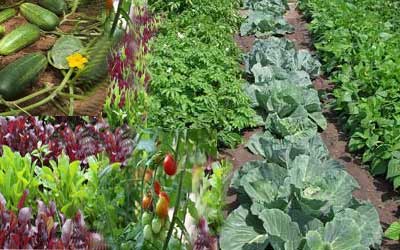Plant diversity
 Intercropping (multi cropping, poly cropping) is defined as the growth of two or more crops in proximity in the same field during a growing season to promote interaction between them. Available resources such as light, water and nutrients are more completely absorbed and converted to crop biomass by this system. The most common advantage of intercropping is the production of greater yield on a given piece of land by making more efficient use of the available growth resources.
Intercropping (multi cropping, poly cropping) is defined as the growth of two or more crops in proximity in the same field during a growing season to promote interaction between them. Available resources such as light, water and nutrients are more completely absorbed and converted to crop biomass by this system. The most common advantage of intercropping is the production of greater yield on a given piece of land by making more efficient use of the available growth resources.
Intercropping was a common practice in Kerala before the developments of plantation farming during the British ruling period. Intercropping offers a number of significant enhancements of both the net productivity and the ecosystems in farming region. This ecological method can manage pests, diseases and weeds via natural competitive principles that allow for more efficient resource utilisation.
 The selection of an appropriate intercropping system for each case is quite complex as the success of intercropping systems depend much on the interaction between the component species, the available management practices, and the environmental conditions. While selecting the crops for intercrop system, the crops involved may have different resource requirements and growth parameters. Proper selection of compatible intercrops, manuring and adoption of scientific intercrop management practices are absolutely essential for worthwhile multicropping. Features of an intercropping system can differ largely with soil conditions, local climate, economics situation and preference of the local community. A mixture of crops of different rooting ability, canopy structure, height and nutrient requirements can do the complimentary utilisation of growth resources by the component crops.
The selection of an appropriate intercropping system for each case is quite complex as the success of intercropping systems depend much on the interaction between the component species, the available management practices, and the environmental conditions. While selecting the crops for intercrop system, the crops involved may have different resource requirements and growth parameters. Proper selection of compatible intercrops, manuring and adoption of scientific intercrop management practices are absolutely essential for worthwhile multicropping. Features of an intercropping system can differ largely with soil conditions, local climate, economics situation and preference of the local community. A mixture of crops of different rooting ability, canopy structure, height and nutrient requirements can do the complimentary utilisation of growth resources by the component crops.
Intercropping also used to practice of sowing a fast growing crop with slow -growing crop, so that the first crops harvested before the second crop starts to mature. Kanni and Mundakan method of paddy farming is an existing traditional example in Cherthala land farms (Karappadam).
Advantages
- Protection of plants from the host specific predators and disease organisms.
- Greater competition towards weeds, pest and diseases.
- Use of nitrogen fixing plants enhances the growth of the other plants.
- The roots of each plant type are of varying lengths; the plants can source sufficient nutrition from the different layers of soil.
- Provides insurance against crop failure or against unstable market prices for a given commodity.
- Allows lower inputs through the reduced fertiliser and pesticide requirements
- Intercropping of compatible plants promotes biodiversity by providing a habitat for a variety of insects and soil organisms that would not be present in a single crop environment.






